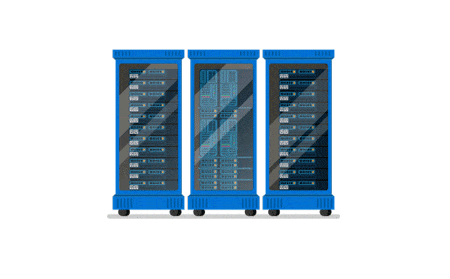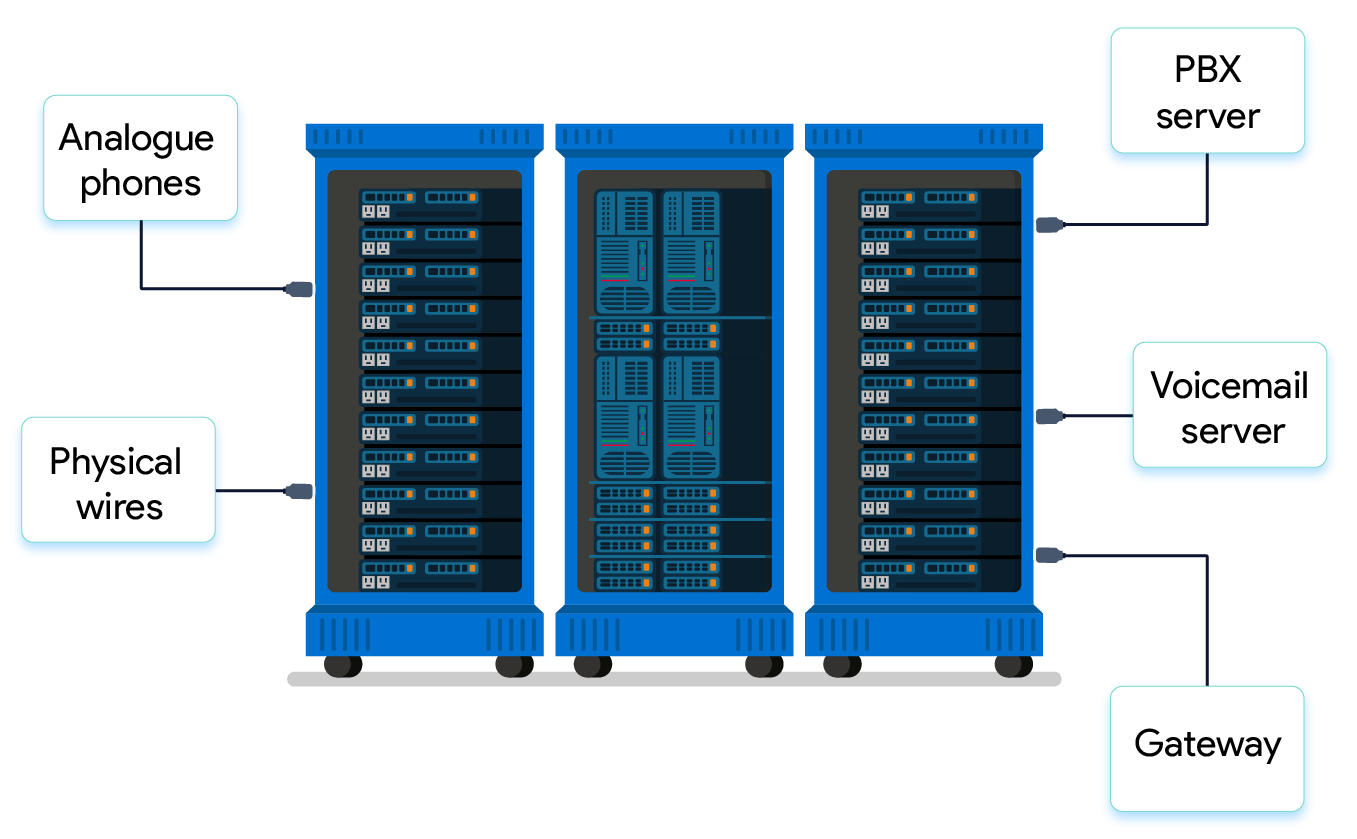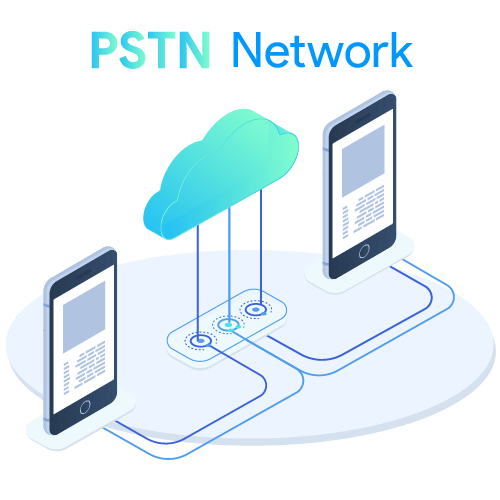Is a PBX Phone System the Right Choice for your Business?
Find out what PBX means, how it works, what problems it solves, and advantages & disadvantages of PBX phone systems (& alternatives).

PBX or private branch exchange is a telecommunications device used by businesses to route all the calls made within, to, and from their phone network. A PBX connects a business’ internal phone lines to each other and to the PSTN (Public Switched Telephone Network).
It has the intelligence to route incoming and outgoing calls based on pre-set rules programmed into it. Each terminating device connected to a PBX is called an “extension” and is assigned a unique (within that network) phone number.
Private Branch Exchange phone systems are multi-line phone networks that enable voice communication for businesses over the PSTN. They use circuit switching telephony to send and receive voice messages, which simply means that they convert voice messages to analogue signals and then transmit these signals over the PSTN.

A PBX phone system has the following components:
1. Private Branch Exchange Server: This is the main component of PBX phone systems. It handles everything from call routing to voicemail.
2. Voicemail server: This is where the recorded voice resides for automated greetings, and where all voicemail is stored.
3. Gateway: This connects your PBX to the PSTN.
4. Analogue phones: These phones are used by agents to make and receive calls. They are connected to the PBX via phone lines.
5. Physical wires: These connect the analogue phones to the PBX.
Before PBXs came into the picture, if a business had 50 agents, they needed to buy 50 phone lines. This was undesirable due to the following reasons:
It was expensive to buy separate phone lines. Additionally, the businesses incurred high costs even for internal communication.
It led to a waste of resources. It’s highly unlikely that all 50 agents will be speaking to customers simultaneously.
A PBX solved all these problems. It was more cost-effective than buying 50 phone connections, it optimized the number of phone lines needed – for 50 agents, businesses needed to buy only 7-10 phone lines, and internal communication became entirely free of cost.
One of the primary advantages of a PBX phone system is the fact that they share a trunk line with internal phones. This results in free internal communication.
Reduces the number of phone lines that need to be purchased. For 50 agents, businesses need to buy only 7-10 phone lines since all communication is optimized by the PBX.
PBX phone systems offer additional features for call management that allow businesses to handle high call volumes in an organized manner.

PBX phone systems are infrastructure-heavy. They require components like PBX server, physical wires, voicemail server, etc to be bought and stored on-premises.

They’re prone to downtime. If there’s anything wrong with the primary server, the entire phone system comes to a standstill.
They are extremely expensive to set up and maintain as compared to the alternative, cloud phone systems. Most businesses take years to break even on this investment.
They are difficult to maintain and offer low flexibility and control. It requires hours to add or remove a single agent and maintenance is dependant on the vendor’s support.
PBX systems don’t offer the analytics and visibility a cloud phone system does. This gives businesses no insight into their communication patterns and trends, making it hard to optimize processes.
PBX phone systems solved a lot of problems back in the day, but they have now evolved beyond the old on-premise model. Today, alternatives offer ease of use, better functionality, low-maintenance, and cost-efficiency which is hard to compete with.
While many businesses across the globe have moved on to other types of business phone systems, a sizeable chunk of businesses still use PBX phone systems. This is primarily because of the investments they’ve already made in their PBX infrastructure that they find hard to let go of.
The communication landscape has changed drastically and businesses can no longer afford to be stuck in rigid and archaic infrastructure. All things considered, PBX phone systems only meet the minimum requirements of business communication at present, and some might even argue against that.
Business communication needs have evolved and so have the channels that enable them. Here are three alternatives to PBX phone systems that better serve the needs of business communication today:

Most of the PBX infrastructure is hosted on cloud, and all you need are phones. In this setup, you don’t need to buy bulky, expensive hardware. You can even route calls directly to agents’ mobile phones using cloud phone systems, enabling your agents to work remotely. This gives you the complete functionality of on-prem PBX along with a whole slew of innovative features.
The infrastructure on the on-prem VoIP phone systems is similar to PBX phone systems. The difference is that all communication happens over the Internet instead of the PSTN and that you can transfer a whole lot more than just voice via these channels. These systems also offer better features.


This again offers the complete functionality of on-prem VoIP phone systems, with additional features. You get the best of both worlds – no infrastructure required (except VoIP phones) and access to all the functionality of an on-prem VoIP phone system.
Enterprises and small businesses alike are increasingly moving to cloud-based telephone systems. Cloud telephony is playing an important role amidst the pandemic in enabling customer communication. In fact, it has now become an important part of the business continuity plans of numerous companies.
The pandemic may have been a catalyst for the shift, but this is as good a time as any to switch over to cloud telephony. Here are six reasons why cloud PBX systems are better than conventional PBX phone systems:
You can have your telephony system up and running in less than an hour if implemented via cloud telephony whereas it can take up to days to set up a traditional business phone system. Exotel takes care of the hardware and software involved, freeing up time for your core business activities.
Cloud telephony gives you more control and flexibility over your business telephony system. With Exotel, you can add/remove agents on the go whereas it requires a lot more time and effort in doing the same in a traditional setup.
Exotel empowers you with data and allows you to have a bird’s-eye view over your department’s operations. Our detailed reports give you the insights required to improve processes and increase productivity while allowing you to accurately track each and every KPI for all your agents.
Moving to the cloud means that your employees can make and receive calls from anywhere, anytime. This results in an increase in call-pickup rates and overall productivity.
Empower your teams by integrating cloud telephony with your favourite CRM or help desk tool. This makes things convenient by enabling your agents to make and receive calls contextually, from within the dashboard.
Exotel grows with you and scales seamlessly to accommodate all of your business needs, in a pay-as-you-go model. This is a far cry from all the time, effort, and costs involved in scaling an on-prem telephony system.
As technology advances and customers’ expectations grow, companies are adopting better ways of communicating with their customers. More and more businesses are migrating to VoIP or cloud phone systems for the many advantages these systems offer.
PBX still retains a significant market share when it comes to business phone systems and will continue to do so for years. However, the adoption of alternatives is increasing steadily and businesses need to seriously consider all the options available before making a choice.
ISO 27001:2013 certified information security management system
Gain competitive advantage from patented products
Best success rates, voice quality and reduced latency
Grow at will, expand without worrying about infrastructure
Best in class uptimes of 99.94% including operator uptimes
24×7 customer support via phone, email and Twitter

